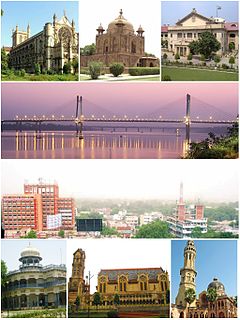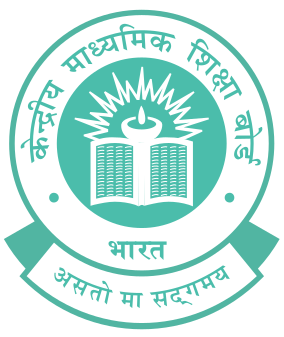
Uttar Pradesh is a state in northern India. With over 200 million inhabitants, it is the most populated state in India as well as the most populous country subdivision in the world. It was established in 1950 after India had become a republic. It was a successor to the United Provinces (UP) during the period of the Dominion of India (1947–1950), which in turn was a successor to the United Provinces (UP) established in 1935, and eventually of the United Provinces of Agra and Oudh established in 1902 during the British Raj. The state is divided into 18 divisions and 75 districts, with the state capital being Lucknow, and Allahabad serving as the judicial capital. On 9 November 2000, a new state, Uttaranchal, was created from Uttar Pradesh's western Himalayan hill region. The two major rivers of the state, the Ganges and its tributary Yamuna, meet at the Triveni Sangam in Allahabad, a Hindu pilgrimage site. Other notable rivers are Gomti and Saryu. The forest cover in the state is 6.1% of the state's geographical area. The cultivable area is 82% of total geographical area and net area sown is 68.5% of cultivable area.
The Secondary School Certificate, also called SSC or Matriculation examination, in madrasah education Dakhil is a public examination in India, Bangladesh and Pakistan conducted by educational boards for the successful completion of the secondary education exam in these countries. Students of 10th grade/class ten can appear in these. It is equivalent to GCSE in England and first two years of high schools in United States.
An examination board is small board organization that sets examinations, is responsible for marking them, and distributes results. Some are run by governmental entities; some are run as not-for-profit organizations.

The University of Allahabad is a collegiate central university located in Allahabad, Uttar Pradesh, India. It was established on 23 September 1887 by an Act of Parliament and is recognised as an Institute of National Importance (INI). It is one of the oldest modern universities in India. Its origins lie in the Muir Central College, named after Lt. Governor of North-Western Provinces, Sir William Muir in 1876, who suggested the idea of a Central University at Allahabad, which later evolved to the present university. At one point, it was known as the "Oxford of the East". Its Central University status was re-established through the University of Allahabad Act 2005 by the Parliament of India.

Kulpahar is a city in Mahoba district in the Indian state of Uttar Pradesh. It is a historical town in the Bundelkhand region. Before 11 Feb 1995 Kulpahar was a Tehsil of Hamirpur District. On 11 Feb 1995 Mahoba District was carved out of Hamirpur, and Kulpahar is now a part of the Mahoba District. Kulpahar is the largest Subdivision of Uttar Pradesh. Kulpahar is known for its closeness to Khajuraho and other historic places like Mahoba, Charkhari, Kalinjar Rath, Orchha, and Jhansi. This town holds relics of temples and man-made water bodies of the Chandela Dynasty
National Law Universities (NLU) or National Law Schools are central public law schools in India, founded pursuant to the second-generation reforms for legal education sought to be implemented by the Bar Council of India. These law schools are regulated by the Bar Council of India and are under the ownership of Ministry of Law and Justice, Government of India. The first NLU was the National Law School of India University (NLSIU), located at Bangalore, which admitted its first batch in 1988. Since then, most of the states in India have established a NLU. Currently there are 23 NLUs across the country. Since their inception, these law schools have continuously been ranked as India's most prestigious and premier law schools by various agencies and have been ranked amongst the best law schools globally by leading agencies like Quacquarelli Symonds (QS) and Times Higher Education. The admissions to these universities is conducted through the Common Law Admission Test (CLAT) and is extremely competitive with an acceptance rate of as low as 2 to 3 percent.
The Higher Secondary Certificate (HSC) is a public examination credential in Bangladesh, India, and Pakistan. HSC is equivalent to GCE A Level in England and 3rd and 4th year of high schools in the United States.

Allahabad, officially known as Prayagraj, also known as Ilahabad, is a metropolis in the Indian state of Uttar Pradesh. It is the administrative headquarters of the Allahabad district—the most populous district in the state and 13th most populous district in India—and the Allahabad division. The city is the judicial capital of Uttar Pradesh with the Allahabad High Court being the highest judicial body in the state. As of 2011, Allahabad is the seventh most populous city in the state, thirteenth in Northern India and thirty-sixth in India, with an estimated population of 1.53 million in the city. In 2011 it was ranked the world's 40th fastest-growing city. Allahabad, in 2016, was also ranked the third most liveable urban agglomeration in the state and sixteenth in the country. Hindi is the most widely spoken language in the city.
The State Entrance Examination - Uttar Pradesh Technical University(SEE-UPTU) is an annual college entrance examination in Uttar Pradesh for engineering, architecture, pharmacy and management courses. All institutions affiliated to Dr. A.P.J. Abdul Kalam Technical University admit students through centralized counselling of SEE-UPTU. The private institutions may, however, admit 15% of the total intake directly. The exam is conducted by Dr. A.P.J. Abdul Kalam Technical University. It is one of the highly reputed exams of India.

The state of Uttar Pradesh had a small tradition of learning, although it had remained mostly confined to the elite class and the religious establishment.

The Central Board of Secondary Education (CBSE) is a national level board of education in India for public and private schools, controlled and managed by the Government of India. Established in 1929 by a resolution of the government, the Board was indeed a bold experiment towards inter-state integration and cooperation in the sphere of secondary education. There are approximately 26,054 schools in India and 240 schools in 28 foreign countries affiliated to the CBSE. All schools affiliated to CBSE follow the NCERT curriculum especially from class 9 to 12. The current Chairperson of CBSE is Vineet Joshi IAS.

The Board of Intermediate Education, Andhra Pradesh (BIEAP) is a board of education in Andhra Pradesh, India. Established in 1971, it was located in Hyderabad, situated in the composite Andhra Pradesh state. The board is now located in Vijayawada after state reorganization in 2014. The board offers two-year courses in 85 streams and courses and conducts examinations.

Madhya Pradesh Board of Secondary Education is a board of school education in Madhya Pradesh State of India.

Government Inter College Deoria or GIC Deoria is a historical college. Located in the Deoria district, Uttar Pradesh, India and is 2 km (1.2 mi) away from the Deoria Railway Station and 2.9 km (1.8 mi) away from the Deoria Bus Stand. The old name of this college was King Edward High School. It was established on 8 October 1912. Its current principal is Mr. P. K. Sharma. There are hostels here and there is also two bicycle stand.
The Teacher Eligibility Test, known as TET, is the minimum qualification required in India for a person to be eligible for an appointment as a teacher for Classes I to VIII. The test is mandatory for teaching jobs in Indian government schools. Similarly, UP Government introduced another qualifying after UPTET called Super TET. The TET is conducted by both the central and state governments of India. Most states conduct their own TET. The test is conducted to meet the objectives of the Right of Children to Free and Compulsory Education Act, 2009. The TET certificate is valid for lifetime.

The Uttar Pradesh Public Service Commission (UPPSC) is the state agency authorized to conduct the Civil Services Examination for entry-level appointments to the various Group A and Group B Civil Services of Uttar Pradesh. The agency's charter is granted by the Constitution of India. Articles 315 to 323 of Part XIV of the constitution, titled Services Under the Union and the States, provide for a Public Service Commission for the Union and for each state.
Himachal Pradesh Board of School Education is agency Government of Himachal Pradesh entrusted with the responsibilities of prescribing courses of instructions and text books and conducting examinations for secondary school students in Himachal Pradesh. It was set up in 1969 and has its headquarters in Dharmshala. Kultar chand Rana from Kangra was the first chairman. At present more than 8000 schools are affiliated with the Board. The Board sets up 1650 examination centres for over 500,000 examinees every year. Sh Akshey Sood (HAS) is the current Secretary of the HPBOSE appointment by the Government of Himachal Pradesh. Dr Suresh Soni is the current chairman of the board.

The National Institute of Open Schooling (NIOS), formerly National Open School, is the board of education under the Union Government of India. It was established by the Ministry of Human Resource Development of the Government of India in 1989 to provide education to all segments of society under the motive to increase literacy and aimed forward for flexible learning. The NIOS is a national board that administers examinations for Secondary and Senior Secondary examinations similar to the CBSE and the CISCE. It also offers vocational courses after the high school.
Free Laptop Distribution scheme : मुफ्त लैपटॉप वितरण योजना -: This is an initiative of the Government of Uttar Pradesh headed by Akhilesh Singh Yadav of Samajwadi Party to provide 1,00,000 rupees laptops and computer tablets to the students in the state who pass the high school and intermediate examinations to encourage them for higher studies. A total of 15 Lakh laptops have been distributed by the Government of Uttar Pradesh between 2012-2015, making it one of the largest distribution scheme ever imitation by any Government in the world.
Uttarakhand Board of School Education abbr. UBSE is an agency of Government of Uttarakhand entrusted with the responsibilities of prescribing courses of instructions and text books and conducting examinations for secondary school students in Uttarakhand. It is also responsible for result declaration of Board examination. It was set up in 2001 and has its headquarters in Ramnagar. At present more than 10,000 schools are affiliated with the Board. The Board sets up over 1,300 examination centres for over 300,000 examinees every year.











